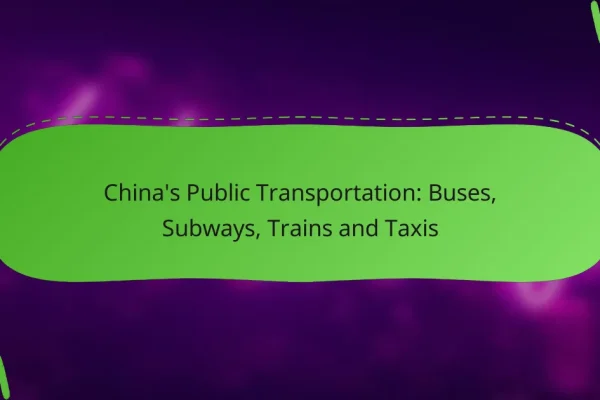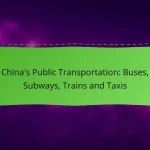What are the best transportation options in China?
The best transportation options in China include high-speed trains, domestic flights, public buses, ride-sharing services, and bicycles or e-scooters. Each option has its own advantages and considerations, making it essential to choose based on your travel needs and destinations.
High-speed trains
High-speed trains are one of the most efficient ways to travel across China, connecting major cities at speeds often exceeding 300 km/h. The extensive rail network allows for quick journeys, such as traveling from Beijing to Shanghai in about 4.5 hours.
Tickets can be purchased online or at train stations, with prices varying based on distance and class. Booking in advance is advisable, especially during peak travel seasons like Chinese New Year.
Domestic flights
Domestic flights are ideal for long distances, particularly when traveling to less accessible regions. Major airlines operate numerous routes, with flight times typically ranging from 1 to 3 hours for most city pairs.
While flights can be more expensive than trains, they save time. It’s best to compare prices and book early to secure the best deals, especially for popular routes.
Public buses
Public buses are a cost-effective way to navigate cities and rural areas. They are widely available and offer extensive coverage, making them a practical choice for budget travelers.
Bus fares are generally low, often just a few yuan, but schedules can be less reliable. Familiarize yourself with local routes and schedules, and consider using apps for real-time information.
Ride-sharing services
Ride-sharing services like Didi Chuxing are popular in urban areas, providing convenient and flexible transportation. Users can book rides via mobile apps, making it easy to navigate cities without needing to know local taxi regulations.
While generally affordable, prices can surge during peak hours. Always check the estimated fare before confirming your ride to avoid unexpected costs.
Bicycles and e-scooters
Bicycles and e-scooters are increasingly common in Chinese cities, offering an eco-friendly way to explore. Many cities have bike-sharing programs, allowing users to rent bikes or scooters for short trips.
These options are typically inexpensive, with rental fees often starting at just a few yuan. However, be mindful of local traffic laws and designated bike lanes to ensure safety while riding.
How to choose the right transportation in China?
Choosing the right transportation in China depends on your travel distance, budget, and time constraints. Assessing these factors will help you select the most suitable option for your journey.
Consider travel distance
Travel distance is a crucial factor when selecting transportation in China. For short distances, local buses, taxis, or ride-sharing services like Didi are often the most convenient. For longer journeys, consider high-speed trains or domestic flights, which can cover hundreds of kilometers efficiently.
As a general guideline, distances under 100 kilometers are best suited for buses or taxis, while distances over 300 kilometers may warrant a train or flight for optimal convenience.
Evaluate cost-effectiveness
Cost-effectiveness varies significantly among transportation options in China. Public transportation, such as buses and subways, is typically the most affordable, often costing just a few yuan for a ride. High-speed trains offer a balance between comfort and price, with fares ranging from low tens to a few hundred yuan depending on the distance.
When evaluating costs, consider not only the ticket price but also potential additional expenses like luggage fees or taxi fares to and from stations. Always compare options to find the best deal for your travel needs.
Assess time efficiency
Time efficiency is essential when choosing transportation in China, especially for business travelers or those on a tight schedule. High-speed trains can travel at speeds of up to 300 km/h, making them a fast option for intercity travel. Flights may seem quicker, but factoring in airport check-in and security can add significant time.
For urban travel, subways and buses can be efficient, but they may face delays during peak hours. Always check travel times in advance to ensure you arrive at your destination on schedule.
What are the advantages of high-speed trains in China?
High-speed trains in China offer numerous advantages, including significantly reduced travel times, enhanced comfort, and a vast network that connects major cities. These benefits make them a popular choice for both domestic and international travelers.
Fast travel times
High-speed trains in China can travel at speeds exceeding 300 km/h (approximately 186 mph), allowing passengers to cover long distances in a fraction of the time compared to traditional trains. For example, a journey from Beijing to Shanghai, which can take over 12 hours by regular train, can be completed in about 4.5 hours on a high-speed train.
This efficiency is particularly beneficial for business travelers and tourists who want to maximize their time in different cities. With frequent departures, travelers can easily plan their trips around their schedules.
Comfortable seating
High-speed trains in China provide comfortable seating options, including spacious legroom and reclining seats, which enhance the travel experience. Passengers can choose from different classes, such as first class and second class, each offering varying levels of comfort and amenities.
Additionally, many trains feature onboard services such as food and beverage carts, power outlets, and Wi-Fi, making the journey more enjoyable. This level of comfort is a significant improvement over many other forms of transportation.
Extensive network coverage
China’s high-speed rail network is one of the largest in the world, connecting over 30 major cities. This extensive coverage allows travelers to easily access urban centers and popular tourist destinations without the need for connecting flights or long drives.
With routes spanning from the north to the south and east to west, passengers can travel between cities like Guangzhou, Chengdu, and Xi’an with ease. The convenience of this network encourages more people to choose rail travel over other modes of transportation.
What are the costs associated with domestic flights in China?
The costs of domestic flights in China can vary significantly based on factors such as the airline, route, and time of booking. Generally, travelers can expect to pay anywhere from a few hundred to over a thousand Chinese Yuan for a one-way ticket.
Ticket price ranges
Domestic flight ticket prices in China typically range from around 300 to 1,500 CNY for economy class. Prices can be lower for less popular routes or during off-peak seasons, while major routes like Beijing to Shanghai may see higher fares, especially during holidays.
Budget airlines often offer lower fares, but these may come with fewer amenities. It’s advisable to compare prices across different airlines and booking platforms to find the best deal.
Additional fees
When booking domestic flights in China, be aware of potential additional fees. Common charges include baggage fees for checked luggage, which can range from 50 to 300 CNY depending on the airline and weight. Some airlines also impose fees for seat selection and in-flight meals.
Always check the airline’s policy on additional charges before booking to avoid surprises. Reading the fine print can help you understand what is included in your ticket price.
Booking tips for savings
To save on domestic flights in China, consider booking tickets well in advance, as prices tend to rise closer to the departure date. Utilizing flight comparison websites can help identify the lowest fares available.
Traveling during weekdays or off-peak seasons can also yield significant savings. Additionally, signing up for airline newsletters may provide access to exclusive promotions and discounts.
What are the public transportation options in major Chinese cities?
Major Chinese cities offer a variety of public transportation options, including subways, buses, and taxis. These systems are designed to provide efficient and cost-effective travel for both residents and visitors.
Subway systems
Subway systems in major Chinese cities, such as Beijing and Shanghai, are extensive and well-developed. They provide a fast and reliable means of transportation, often with trains arriving every few minutes during peak hours.
Fares are generally affordable, typically ranging from CNY 3 to CNY 10 depending on the distance traveled. Most subway stations are equipped with signs in both Chinese and English, making navigation easier for non-Chinese speakers.
When using the subway, consider purchasing a transportation card for convenience, as it allows for seamless travel across different modes of public transport. Avoid peak hours if possible, as trains can become very crowded.












